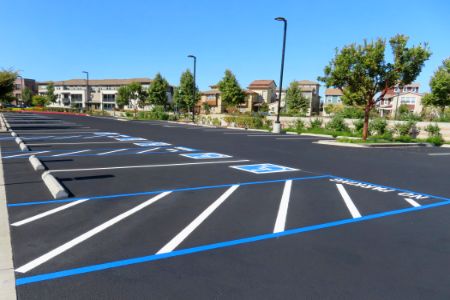Parking Lot Striping Standards in California: Stall Sizes, Blue Curb & Fire Lanes

Managing a busy property in Los Angeles means keeping your parking lot clear, safe, and compliant. California rules for stall layout, accessible markings, and fire lanes guide how every line, symbol, and curb color should look. In this guide, we explain what matters in Los Angeles so you can plan maintenance with confidence, then schedule professional parking lot striping when it is time to refresh your lot.
From Downtown to the Valley, sun, traffic, and sea air fade paint fast. A clear plan helps avoid confusion, collisions, and complaints. It also helps your business look sharp to customers, tenants, and inspectors.
Parking lot striping in los angeles: what property managers need to know
Los Angeles lots see year-round use. Morning school rush, lunchtime pickups, and weekend events push traffic across tight aisles. Fresh lines are not just about looks. Fresh, high-contrast striping improves safety and reduces liability by guiding drivers and pedestrians through the site.
Local expectations are shaped by state and federal standards for accessible parking and traffic control, plus city fire and building policies. You get the best results when your layout, paint, symbols, and signs all support the same plan.
Stall sizes and layouts in California parking lots
Stall layout starts with your site’s circulation and land use. California references common classes of stalls and markings, while Los Angeles agencies and your fire authority may refine what they want to see. Typical plans include a mix of standard stalls, compact areas where allowed, accessible spaces, loading zones, and clearly marked aisles.
- Standard and compact areas are grouped to keep traffic smooth and reduce tight turns.
- Accessible stalls sit close to main entrances with a clear route free of steps or hazards.
- Loading and pickup zones stay out of fire lanes and do not block drive aisles.
- Directional arrows, stop bars, and crosswalks guide drivers and protect pedestrians.
Exact stall counts and layout rules vary by use type, occupancy, and local policy. Your designer should confirm current requirements before paint hits the pavement.
accessible parking: blue curbs, symbols, and signage
California requires visible, consistent markings for accessible parking. This includes the familiar wheelchair symbol, blue borders or field color where specified, and hatch-marked access aisles. A compliant sign package is just as important as the paint on the ground. Missing or incorrect accessible signage can lead to fines and can make your site hard to use for people who need it most.
In Los Angeles, expect attention to the access aisle next to each accessible stall, the “van accessible” designation where required, and a smooth, direct path of travel to the entrance. Keep the surface maintained so symbols and hash marks remain readable from a car window.
fire lanes and red curb markings in los angeles
Fire department access is a top priority. Red curb markings and clear fire lane stencils help keep critical drive aisles open for emergency vehicles. The width of these lanes and exact wording can vary by site and fire authority. Always verify current requirements with your local fire authority during design or restriping, especially if your site has gates, speed humps, or loading zones close to entrances.
Paint fades faster on corners and curb faces. Never paint over red curbs or block fire lane wording with wheel stops, planters, or signs. Keep sight lines open by trimming landscaping that hides stencils or signs.
materials and visibility that stand up to la weather
Sun, heat, and airborne dust in Los Angeles can dull lines quickly. Near the coast, salt and moisture add wear. Choosing the right materials helps your markings pop longer between maintenance cycles.
- High-solids traffic paints offer strong color and film build for busy lots.
- Contrast matters. Bright white for lanes, bold yellow for caution zones, deep blue for accessible areas, and true red for fire lanes improve quick recognition.
- Glass beads increase nighttime retroreflectivity so arrows, stop bars, and crosswalks stand out under headlights.
- Surface prep is key. Clean, dry pavement helps paint bond and cure well.
Thermoplastic and specialty coatings may be considered for high-wear areas like entrances or tight turn pockets. Discuss options that balance longevity, cure time, and your operating hours.
Planning tips before your next restripe
Walk your lot during peak and off-peak hours. Note where drivers hesitate, stack up, or cut across empty stalls. These are signals that wayfinding needs help. Add arrows, adjust stall orientation where allowed, or improve crosswalk placement so the pattern feels natural.
Check that accessible routes remain smooth and free of barriers. Confirm that red curbs and fire lane wording are visible where emergency vehicles need to stage or turn. If your operations change, such as adding curbside pickup, update markings so the new use does not conflict with fire access.
To see how we approach design, coating selection, and schedule planning across Los Angeles, you can review our work and services from the home page by visiting parking lot striping Los Angeles. This gives you a snapshot of our process before you schedule a site walk.
Ready for safer, cleaner parking lines in Los Angeles?
Clear lines make a fast first impression. They also support safety and compliance in a city that never slows down. When you partner with R. E. Temple Coatings & Specialty Services, you get a team that understands California standards and Los Angeles expectations. We make your lot simple to use and simple to maintain.
Let us help you plan a layout refresh, update accessible markings, and renew red curbs for reliable fire access. Call 909-643-2353 to schedule a walk-through, or learn more on our service page for parking lot striping in Los Angeles. We look forward to making your lot safer, clearer, and easier to navigate.

Give Your Business A Fresh Look. Contact Our Coatings & Specialty Services Experts Today, We Operate in 5 Counties.